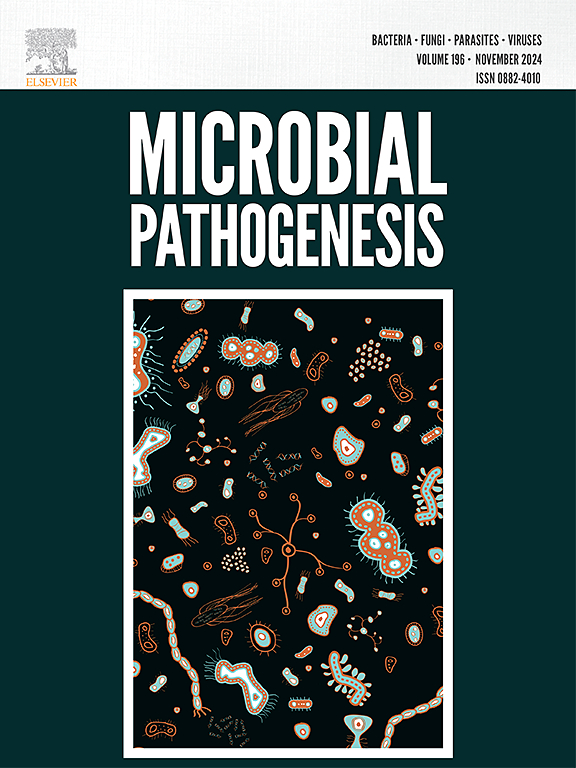First report of natural co-infections and protein profile of Indian major carp, Labeo rohita
IF 3.5
3区 医学
Q3 IMMUNOLOGY
引用次数: 0
Abstract
Aquaculture is a crucial component of global animal protein production, highlighting its significant role in food security. Bacterial co-infections are common in fish farms and severely impact fish health. The prevalence of Aeromonas and Pseudomonas species has been documented in natural co-infections on rohu farms. Infected fish exhibited prominent ulcerative skin lesions, scale erosion, and tail rot. Molecular analysis revealed that Aeromonas veronii was the most dominant species in infected tissues, followed by A. hydrophila, A. dhakensis, Pseudomonas mosselii, and P. fluorescens. The coinfected fish displayed histopathological changes, such as necrotic gills, lymphocytic infiltration, and tubular necrosis in the liver and kidney. Antibiotic susceptibility profiling using nine antibiotic discs indicated the highest sensitivity to oxytetracycline, whereas ampicillin, methicillin, and penicillin exhibited complete resistance across all tissue-associated bacterial isolates. Label-free proteomic analysis of the kidney showed pathogenicity mechanisms related to metabolic pathways, ion binding, oxidoreductase activity and the cellular response to stress in the kidneys of coinfected rohu. Notably, proteins involved in apoptosis, inflammation, and reactive oxygen species (ROS) regulation were upregulated, suggesting their roles in the host response to coinfection. This study specifies for the first time that coinfection on rohu farms is capable of causing pathological changes in the kidney, liver, and gill. The identification of novel host-response proteins may facilitate the development of therapeutic targets and strategies to increase disease resistance and climate resilience in aquaculture.
印度主要鲤鱼自然共感染及蛋白质谱首次报道。
水产养殖是全球动物蛋白生产的重要组成部分,在粮食安全方面发挥着重要作用。细菌共感染在养鱼场很常见,严重影响鱼类健康。气单胞菌和假单胞菌的流行已在罗虎养殖场的自然共感染中得到证实。受感染的鱼表现出明显的皮肤溃疡、鳞片侵蚀和尾部腐烂。分子分析显示,在感染组织中,维罗氏气单胞菌是最占优势的菌种,其次是嗜水单胞菌、达肯单胞菌、莫塞假单胞菌和荧光单胞菌。同时感染的鱼表现出组织病理学变化,如鳃坏死、淋巴细胞浸润、肝和肾小管坏死。使用9个抗生素圆盘进行抗生素敏感性分析显示,对土霉素的敏感性最高,而氨苄西林、甲氧西林和青霉素在所有组织相关的细菌分离株中表现出完全的耐药性。肾脏无标记蛋白质组学分析显示,共感染罗虎肾脏的致病机制与代谢途径、离子结合、氧化还原酶活性和细胞应激反应有关。值得注意的是,参与细胞凋亡、炎症和活性氧(ROS)调节的蛋白质上调,表明它们在宿主对共感染的反应中起作用。本研究首次明确了罗虎养殖场的共感染可引起肾脏、肝脏和鳃的病理改变。新的宿主反应蛋白的鉴定可能有助于开发治疗靶点和策略,以提高水产养殖的抗病性和气候适应能力。
本文章由计算机程序翻译,如有差异,请以英文原文为准。
求助全文
约1分钟内获得全文
求助全文
来源期刊

Microbial pathogenesis
医学-免疫学
CiteScore
7.40
自引率
2.60%
发文量
472
审稿时长
56 days
期刊介绍:
Microbial Pathogenesis publishes original contributions and reviews about the molecular and cellular mechanisms of infectious diseases. It covers microbiology, host-pathogen interaction and immunology related to infectious agents, including bacteria, fungi, viruses and protozoa. It also accepts papers in the field of clinical microbiology, with the exception of case reports.
Research Areas Include:
-Pathogenesis
-Virulence factors
-Host susceptibility or resistance
-Immune mechanisms
-Identification, cloning and sequencing of relevant genes
-Genetic studies
-Viruses, prokaryotic organisms and protozoa
-Microbiota
-Systems biology related to infectious diseases
-Targets for vaccine design (pre-clinical studies)
 求助内容:
求助内容: 应助结果提醒方式:
应助结果提醒方式:


